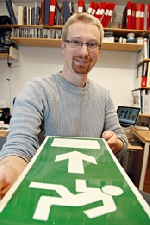Research for safer railway tunnels
– Published 1 March 2011

"We’re going to set fire to two trains. Then we’ll blow them up", says Daniel Nilsson. He is an associate senior lecturer in the Division of Fire Engineering and Risk Management at LTH and is working on a project to improve safety in underground systems and railway tunnels.
The project, called Metro, will improve safety in tunnels and other underground facilities, while protecting the infrastructure itself. Daniel Nilsson is assistant project manager and is focusing particularly on the part of the project that deals with evacuation.
The three-year project started a year ago. It has a budget of just over SEK 14 million and the main funder is Storstockholms Lokaltrafik, SL. In the first phase of the project, information is gathered that will make stations, tunnels and trains safer. The next stage focuses on making actual evacuations safer. In total the project is divided into seven different parts (see fact box below).
In the lab in V-huset at LTH, parts of an underground train have been constructed, on which different experiments are carried out. One feature is a platform from which the passengers have to get down in the event of an evacuation. The construction is very similar to the conditions in the Stockholm underground, and a number of lessons have already been learnt.
“We have seen that 1.4 metres is far too high for elderly people to be able to jump, especially when the landing surface is tarmac”, says Daniel Nilsson.
Other observations that have been made so far are that evacuations take a long time and that it is important to design emergency exits so that it is clear that they are accessible and that their use is permitted. The group has performed evacuation experiments in an IKEA store and in Götatunneln in Gothenburg.
“There we saw that people often don’t use the emergency exits, but rather use ordinary entrances and exits. For example, if it says ‘staff only’ on a door, there is a risk that customers will not use it even in an evacuation situation”, he says.
The best way to make people use emergency exits is to use green flashing lights to indicate the way you want people to go. Red or yellow lights, on the other hand, do not work as well.
The project is interdisciplinary and is led by LTH together with Mälardalen University; SP Technical Research Institute of Sweden and seven other organisations are also involved.
In the summer, a major experiment will be carried out. A real train will be set alight in a tunnel, under the supervision of the researchers. Then the train will be blown up. It is hoped that the experiment will give the researchers a better understanding of fire and explosion risks.
Anders Frick
Fact box:
The Metro project aims to protect infrastructure in underground rail transport facilities. The project has seven parts: design fires, evacuation, integrated fire protection, flammable gas control, extraordinary strain, rescues, and project management. One of the goals is that elderly and disabled people should be able to evacuate safely from an underground train.
